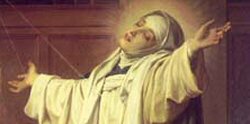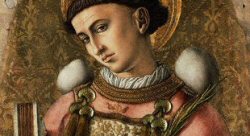One thing is for sure - the Lord has not stopped calling men and women to the priesthood and religious life.
 Before I go any farther, look at the picture to the left. This is the ordination class from ONE Spanish seminary before the Second Vatican Council. (Check out the Altars in front of each group) (hat tip for picture to Greg)
Before I go any farther, look at the picture to the left. This is the ordination class from ONE Spanish seminary before the Second Vatican Council. (Check out the Altars in front of each group) (hat tip for picture to Greg)Now with this picture in mind, from the article:
EMPTY SEMINARIES
Beyond a vague understanding of a need for "more vocations," most Catholics are perhaps unaware of the disaster facing the American priesthood. After skyrocketing from about 27,000 in 1930 to 58,000 in 1965, the number of priests in the United States dropped to 45,000 in 2002. By 2020, there will be about 31,000 priests--and only 15,000 will be under the age of 70, according to a study conducted by Dr. James R. Lothian of Fordham University.
The shortage of priests has created a problem previously unknown to modern Catholics: the priestless parish. Only 3 percent of the parishes in the US--a total of 549--were without a priest in 1965. In 2002 there were 2,928 priestless parishes, about 15 percent of all US parishes. By 2020, a quarter of all parishes, 4,656, will have no priest.
As one would expect, the priest dearth has been fueled by a collapse in the seminarian population. There were 16,300 seminarians in 1930 and 49,000 in 1965. By 2002 the number had plunged to 4,700: a 90 percent decrease. Without any students, countless seminaries across the country have been sold or shuttered. There were 596 seminaries in 1965, and only 200 in 2002.
And empty seminaries result in declining ordinations. While there were 1,575 ordinations to the priesthood in 1965, in 2002 there were 450, a decrease of 350 percent. Taking into account ordinations, deaths and departures, in 1965 there was a net gain of 725 priests. In 1998, there was a net loss of 810.
RELIGIOUS ORDERS DISAPPEARING
The tragedy of the convents has been perhaps even more startling. A host of 138,000 sisters ran the Catholic education and health systems in 1945; their numbers swelled to 180,000 by 1965. In 2002, there were 75,000 sisters, with an average age of 68. By 2020, the number of sisters will drop to 40,000--and of these, only 21,000 will be age 70 or under. One does not have to be Chicken Little to predict that within a generation there will be no nuns.
The same is true for the once-proud religious orders of men. For example, in 1965 there were 5,277 Jesuit priests and 3,559 seminarians; in 2000 there were 3,172 priests and 389 seminarians. There were 2,534 OFM Franciscan priests and 2,251 seminarians in 1965; in 2000 there were 1,492 priests and 60 seminarians. There were 2,434 Christian Brothers in 1965 and 912 seminarians; in 2000 there were 959 Brothers and 7 seminarians. It does not require special training in statistics to conclude that by 2050, if these trends continue, the Jesuits, the Franciscans, and the Christian Brothers, will be the virtually extinct in the US.
Other statistics on the life of the Catholic Church in America tell the same story. At the time of the Council there were 4.5 million students in US parochial schools; now there are 2 million. Before the Council there were less than 400 marriages annulled by Catholic diocesan tribunals in an average year; now there are 50,000. Before the Council 3 out of 4 Catholics attended Mass each week; now the figure is 1 in 4.
Given these alarming facts, one wonders how a movie star like Mel Gibson can sense a Church in extremis, but the American bishops cannot. They know the statistics (which are published by the US Conference of Catholic Bishops), yet take no action to counter the catastrophe.
The bishops do not have a good track record when it comes to responding to crisis. Just as they showed no interest in the sexual abuse of minors--in fact they were sometimes complicit--it is a good bet that the bishops will neglect the emergency that threatens the very existence of the Church in the America.
Kenneth C Jones of St. Louis is the author of Index of Leading Catholic Indicators: The Church since Vatican II, published by Oriens Publishing Co.
Hat tip on the article to Vir Speluncae Catholicus























No comments:
Post a Comment